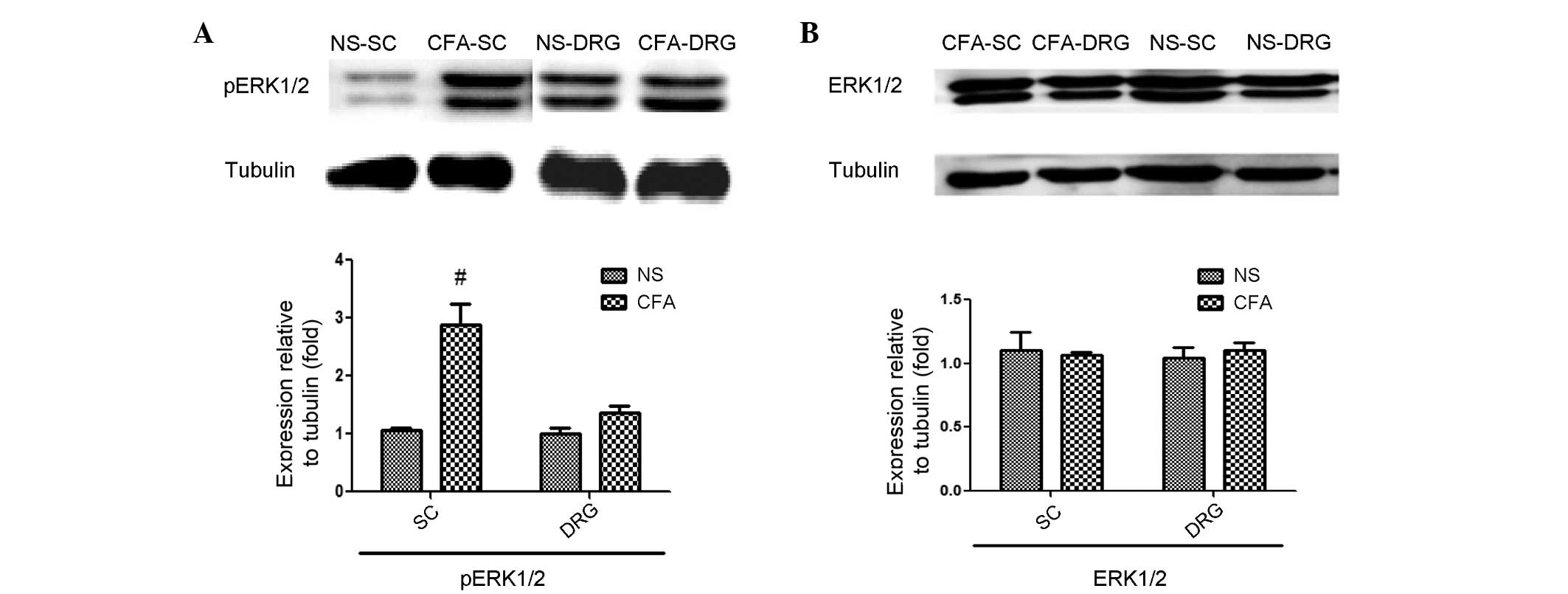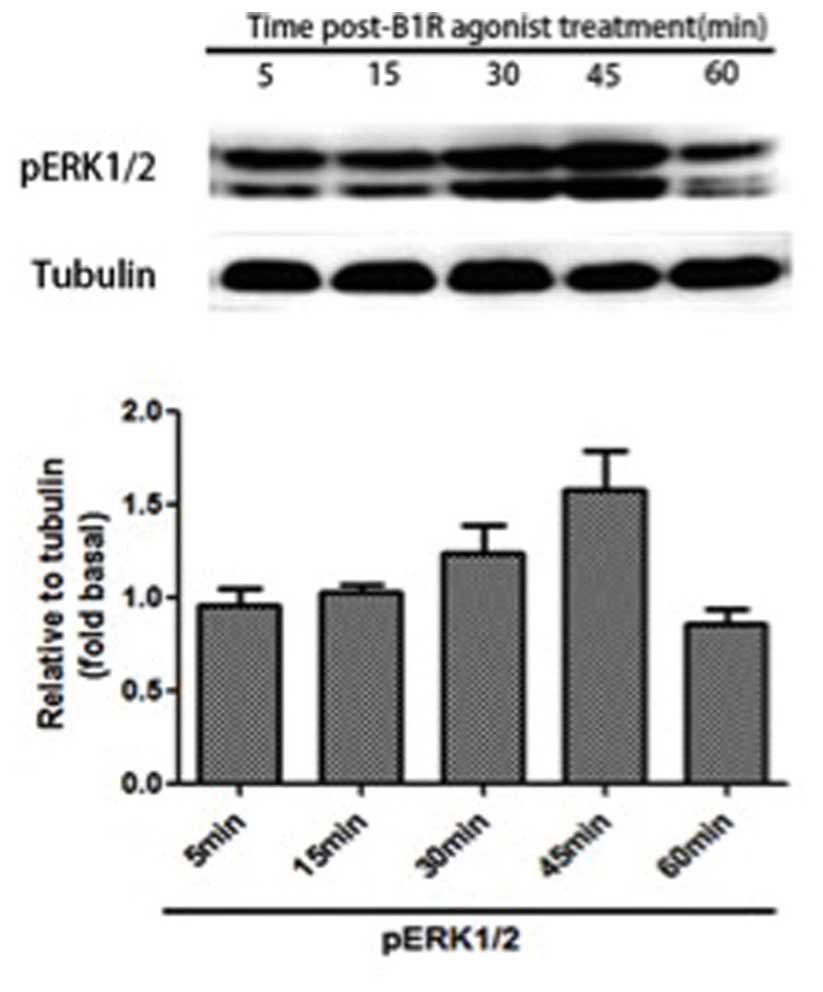|
1
|
Ständer S and Schmelz M: Chronic itch and
pain-Similarities and differences. Eur J Pain. 10:4732006.
View Article : Google Scholar : PubMed/NCBI
|
|
2
|
Ma C, Nie H, Gu Q, Sikand P and Lamotte
RH: In vivo responses of cutaneous C-mechanosensitive neurons in
mouse to punctate chemical stimuli that elicit itch and nociceptive
sensations in humans. J Neurophysiol. 107:357–363. 2012. View Article : Google Scholar : PubMed/NCBI
|
|
3
|
Liu T and Ji R: New insights into the
mechanisms of itch: Are pain and itch controlled by distinct
mechanisms? Pflügers Arch. 465:1671–1685. 2013. View Article : Google Scholar
|
|
4
|
Davidson S and Giesler GJ: The multiple
pathways for itch and their interactions with pain. Trends
Neurosci. 33:550–558. 2010. View Article : Google Scholar : PubMed/NCBI
|
|
5
|
Hosogi M, Schmelz M, Miyachi Y and Ikoma
A: Bradykinin is a potent pruritogen in atopic dermatitis: A switch
from pain to itch. Pain. 126:16–23. 2006. View Article : Google Scholar : PubMed/NCBI
|
|
6
|
Sikand P, Shimada SG, Green BG and LaMotte
RH: Similar itch and nociceptive sensations evoked by punctate
cutaneous application of capsaicin, histamine and cowhage. Pain.
144:66–75. 2009. View Article : Google Scholar : PubMed/NCBI
|
|
7
|
Liang J, Xiao G and Ji W: Capsaicin
induces reflex scratching in inflamed skin. Pharmacology. 88:82–87.
2011. View Article : Google Scholar : PubMed/NCBI
|
|
8
|
Liang J, He Y and Ji W: Bradykinin-evoked
scratching responses in complete Freund's adjuvant-inflamed skin
through activation of B1 receptor. Exp Biol Med (Maywood).
237:318–326. 2012. View Article : Google Scholar : PubMed/NCBI
|
|
9
|
Feng J, Chen Y, Xiong J, Chen X, Liang J
and Ji W: The kinin B1 receptor mediates alloknesis in a murine
model of inflammation. Neurosci Lett. 560:31–35. 2014. View Article : Google Scholar : PubMed/NCBI
|
|
10
|
Fang JQ, Fang JF, Liang Y and Du JY:
Electroacupuncture mediates extracellular signal-regulated kinase
1/2 pathways in the spinal cord of rats with inflammatory pain. BMC
Complement Altern Med. 14:2852014. View Article : Google Scholar : PubMed/NCBI
|
|
11
|
Ji RR, Befort K, Brenner GJ and Woolf CJ:
ERK MAP kinase activation in superficial spinal cord neurons
induces prodynorphin and NK-1 upregulation and contributes to
persistent inflammatory pain hypersensitivity. J Neurosci.
22:478–485. 2002.PubMed/NCBI
|
|
12
|
Zhang L, Jiang GY, Song NJ, Huang Y, Chen
JY, Wang QX and Ding YQ: Extracellular signal-regulated kinase
(ERK) activation is required for itch sensation in the spinal cord.
Mol Brain. 7:252014. View Article : Google Scholar : PubMed/NCBI
|
|
13
|
Kido-Nakahara M, Buddenkotte J, Kempkes C,
Ikoma A, Cevikbas F, Akiyama T, Nunes F, Seeliger S, Hasdemir B,
Mess C, et al: Neural peptidase endothelin-converting enzyme 1
regulates endothelin 1-induced pruritus. J Clin Invest.
124:2683–2695. 2014. View
Article : Google Scholar : PubMed/NCBI
|
|
14
|
Zhao ZQ, Huo FQ, Jeffry J, Hampton L,
Demehri S, Kim S, Liu XY, Barry DM, Wan L, Liu ZC, et al: Chronic
itch development in sensory neurons requires BRAF signaling
pathways. J Clin Invest. 123:4769–4780. 2013. View Article : Google Scholar : PubMed/NCBI
|
|
15
|
Pearson G, Robinson F, Gibson Beers T, Xu
BE, Karandikar M, Berman K and Cobb MH: Mitogen-activated protein
(MAP) kinase pathways: Regulation and physiological functions.
Endocr Rev. 22:153–183. 2001. View Article : Google Scholar : PubMed/NCBI
|
|
16
|
Shaul YD and Seger R: The MEK/ERK cascade:
From signaling specificity to diverse functions. Biochim Biophys
Acta. 1773:1213–1226. 2007. View Article : Google Scholar : PubMed/NCBI
|
|
17
|
Seino D, Tokunaga A, Tachibana T, Yoshiya
S, Dai Y, Obata K, Yamanaka H, Kobayashi K and Noguchi K: The role
of ERK signaling and the P2X receptor on mechanical pain evoked by
movement of inflamed knee joint. Pain. 123:193–203. 2006.
View Article : Google Scholar : PubMed/NCBI
|
|
18
|
Obata K and Noguchi K: MAPK activation in
nociceptive neurons and pain hypersensitivity. Life Sci.
74:2643–2653. 2004. View Article : Google Scholar : PubMed/NCBI
|
|
19
|
Obata K, Yamanaka H, Dai Y, Mizushima T,
Fukuoka T, Tokunaga A and Noguchi K: Differential activation of
MAPK in injured and uninjured DRG neurons following chronic
constriction injury of the sciatic nerve in rats. Eur J Neurosci.
20:2881–2895. 2004. View Article : Google Scholar : PubMed/NCBI
|
|
20
|
Obata K, Yamanaka H, Dai Y, Mizushima T,
Fukuoka T, Tokunaga A and Noguchi K: Activation of extracellular
signal-regulated protein kinase in the dorsal root ganglion
following inflammation near the nerve cell body. Neuroscience.
126:1011–1021. 2004. View Article : Google Scholar : PubMed/NCBI
|
|
21
|
Obata K, Yamanaka H, Dai Y, Tachibana T,
Fukuoka T, Tokunaga A, Yoshikawa H and Noguchi K: Differential
activation of extracellular signal-regulated protein kinase in
primary afferent neurons regulates brain-derived neurotrophic
factor expression after peripheral inflammation and nerve injury. J
Neurosci. 23:4117–4126. 2003.PubMed/NCBI
|
|
22
|
Zhang X, Zhang H, Shao H, Xue Q and Yu B:
ERK MAP kinase activation in spinal cord regulates phosphorylation
of cdk5 at serine 159 and contributes to peripheral inflammation
induced pain/hypersensitivity. PLoS One. 9:e877882014. View Article : Google Scholar : PubMed/NCBI
|
|
23
|
Zhang YL, Shi XD, Fu D, Xu JM and Dai RP:
Activation of spinal ERK1/2 contributes to mechanical allodynia in
a rat model of postoperative pain. Molecular Medicine Reports.
7:1661–1665. 2013.PubMed/NCBI
|
|
24
|
Sanna MD, Mello T, Ghelardini C and
Galeotti N: Inhibition of spinal ERK1/2-c-JUN signaling pathway
counteracts the development of low doses morphine-induced
hyperalgesia. Eur J Pharmacol. 764:271–277. 2015. View Article : Google Scholar : PubMed/NCBI
|
|
25
|
Cevikbas F, Wang X, Akiyama T, Kempkes C,
Savinko T, Antal A, Kukova G, Buhl T, Ikoma A, Buddenkotte J, et
al: A sensory neuron-expressed IL-31 receptor mediates T helper
cell-dependent itch: Involvement of TRPV1 and TRPA1. J Allergy Clin
Immunol. 133:448–460. 2014. View Article : Google Scholar : PubMed/NCBI
|
|
26
|
Ji RR, Baba H, Brenner GJ and Woolf CJ:
Nociceptive-specific activation of ERK in spinal neurons
contributes to pain hypersensitivity. Nat Neurosci. 2:1114–1119.
1999. View Article : Google Scholar : PubMed/NCBI
|
|
27
|
Karim F, Hu HJ, Adwanikar H, Kaplan D and
Gereau RW IV: Impaired inflammatory pain and thermal hyperalgesia
in mice expressing neuron-specific dominant negative mitogen
activated protein kinase kinase (MEK). Mol Pain. 2:22006.
View Article : Google Scholar : PubMed/NCBI
|
|
28
|
Favata MF, Horiuchi KY, Manos EJ, Daulerio
AJ, Stradley DA, Feeser WS, Van Dyk DE, Pitts WJ, Earl RA, Hobbs F,
et al: Identification of a novel inhibitor of mitogen-activated
protein kinase kinase. J Biol Chem. 273:18623–18632. 1998.
View Article : Google Scholar : PubMed/NCBI
|
|
29
|
Song XS, Cao JL, Xu YB, He JH, Zhang LC
and Zeng YM: Activation of ERK/CREB pathway in spinal cord
contributes to chronic constrictive injury-induced neuropathic pain
in rats. Acta Pharmacol Sin. 26:789–798. 2005. View Article : Google Scholar : PubMed/NCBI
|
|
30
|
Kilstein Y, Nowak W, Errasti AE, Feás AA,
Armesto AR, Pelorosso FG and Rothlin RP: Involvement of
Extracellular Signal-Regulated Kinase 5 in Kinin B1 Receptor
Upregulation in Isolated Human Umbilical Veins. J Pharmacol Exp
Ther. 357:114–124. 2016. View Article : Google Scholar : PubMed/NCBI
|
|
31
|
Adwanikar H, Karim F and Gereau RW IV:
Inflammation persistently enhances nocifensive behaviors mediated
by spinal group I mGluRs through sustained ERK activation. Pain.
111:125–135. 2004. View Article : Google Scholar : PubMed/NCBI
|
|
32
|
Gao YJ and Ji RR: Light touch induces ERK
activation in superficial dorsal horn neurons after inflammation:
Involvement of spinal astrocytes and JNK signaling in touch-evoked
central sensitization and mechanical allodynia. J Neurochem.
115:505–514. 2010. View Article : Google Scholar : PubMed/NCBI
|
|
33
|
Xu YM, Wang XT, Zhang ZY, Suo ZW, Yang X
and Hu XD: Noradrenergic α2 receptor attenuated inflammatory pain
through STEP61/ERK signalling. Eur J Pain. 19:1298–1307. 2015.
View Article : Google Scholar : PubMed/NCBI
|
|
34
|
Ferreira J, Campos MM, Pesquero JB, Araujo
RC, Bader M and Calixto JB: Evidence for the participation of
kinins in Freund's adjuvant-induced inflammatory and nociceptive
responses in kinin B1 and B2 receptor knockout mice.
Neuropharmacology. 41:1006–1012. 2001. View Article : Google Scholar : PubMed/NCBI
|
|
35
|
Luo MC, Chen Q, Ossipov MH, Rankin DR,
Porreca F and Lai J: Spinal dynorphin and bradykinin receptors
maintain inflammatory hyperalgesia. J Pain. 9:1096–1105. 2008.
View Article : Google Scholar : PubMed/NCBI
|
|
36
|
Larrivee JF, Bachvarov DR, Houle F, Landry
J, Huot J and Marceau F: Role of the mitogen-activated protein
kinases in the expression of the kinin B1 receptors induced by
tissue injury. J Immunol. 160:1419–1426. 1998.PubMed/NCBI
|
|
37
|
Ehrenfeld P, Matus CE, Pavicic F, Toledo
C, Nualart F, Gonzalez CB, Burgos RA, Bhoola KD and Figueroa CD:
Kinin B1receptor activation turns on exocytosis of matrix
metalloprotease-9 and myeloperoxidase in human neutrophils:
Involvement of mitogen-activated protein kinase family. J Leukoc
Biol. 86:1179–1189. 2009. View Article : Google Scholar : PubMed/NCBI
|
|
38
|
Zhang Y, Adner M and Cardell LO:
Up-regulation of bradykinin receptors in a murine in-vitro model of
chronic airway inflammation. Eur J Pharmacol. 489:117–126. 2004.
View Article : Google Scholar : PubMed/NCBI
|
|
39
|
Bryborn M, Adner M and Cardell LO:
Interleukin-4 increases murine airway response to kinins, via
up-regulation of bradykinin B1-receptors and altered signalling
along mitogen-activated protein kinase pathways. Clin Exp Allergy.
34:1291–1298. 2004. View Article : Google Scholar : PubMed/NCBI
|

















